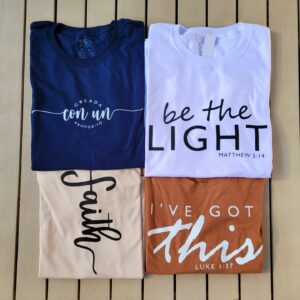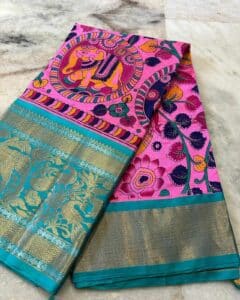Have you just started using DTF printing and are unsure of the best color mode to use? The most common question that comes in the mind of newbies is: Is DTF printing RGB or CMYK?
Look nowhere else! Understanding RGB and CMYK color modes is essential for high-quality DTF prints.
You want your DTF prints to look good, be accurate, and vivid. Achieving these objectives may depend much on the color mode you choose.
We’ll cover the distinctions between RGB and CMYK color modes, their pros and cons, and how to choose the proper color mode for your DTF prints in this blog article.

RGB vs CMYK: What’s the Difference?
RGB and CMYK are digital printing color modes, including DTF printing. Each mode has its own set of benefits and drawbacks, which effect the final print quality.
RGB
An additive color paradigm, RGB stands for Red, Green, and Blue. In this mode, different intensities of red, green, and blue light are combined to generate colors. Electronic displays including computer monitors, TVs, and mobile devices often operate in this mode. For producing vivid and brilliant colors that are perfect for digital displays, RGB is a terrific option. Due to discrepancies in color gamut between electronic displays and printed media, RGB colors are not always faithfully represented in print.
CMYK
Cyan, Magenta, Yellow, and Black, or CMYK, is an abbreviation for a subtractive color model. In this mode, light is subtracted from white paper to produce colors. The default color mode for commercial printing, including DTF printing, is CMYK. CMYK is a wonderful option for producing precise color reproductions in print because it analyzes how ink and paper interact. However, CMYK is harder to use than RGB for brilliant colors.
Digital displays work best with RGB, whereas printing works best with CMYK. In order to produce DTF prints of the highest quality, it is crucial to comprehend the differences between these two color modes.
| Pros & Cons | RGB | CMYK |
|---|---|---|
| Pros | Creates vibrant and bright colors ideal for digital displays. | Produces accurate color reproduction in print. |
| Allows for a wide range of colors. | Takes into account the way ink interacts with paper. | |
| Has a wider color gamut compared to CMYK. | ||
| Cons | Colors may not be accurately represented in print. | Difficult to achieve vibrant and bright colors. |
| Limited to digital displays. | Additional color separation step required for printing. | |
| Can result in color shift when converting to CMYK. |
Which is better for DTF printing, RGB or CMYK?
The color mode you choose for DTF printing depends on the task at hand and the intended result. Let’s examine a few typical DTF applications and which color mode would be more appropriate for each:
- T-shirt printing: Due to its capacity to create vivid and long-lasting prints, DTF printing is becoming more and more well-liked for t-shirt printing. Should t-shirt printing be CMYK or RGB? CMYK is often the superior option for printing t-shirts since it can achieve precise color reproduction on cloth. Additionally, a built-in white ink option is available on a lot of DTF printers, which is important for printing on dark-colored materials. You can use RGB also to print t-shirts, but it’s harder to get realistic colors on cloth.

- Custom labels and stickers: To maintain brand coherence, custom labels and stickers need exact color reproduction. Given that CMYK is the common color mode that industries use in commercial printing, it is the best option in this situation. CMYK can also create excellent prints on a range of materials, such as vinyl and polyester.
- Packaging: Printing on various materials, such as cardboard, plastic, and paper, is often used in packaging. CMYK is once again the superior option in this scenario since it can provide precise and reliable color reproduction on a range of materials.
- Fine art printing: To accurately depict the original artwork, fine art printing demands high-quality color reproduction. RGB has a larger color range and produces rich, display-friendly colors, making it a superior option for fine art printing.
DTF printing can use RGB or CMYK depending on the application. For fine art printing and other applications that need a larger color spectrum, RGB can be better than CMYK. Your DTF printing demands and materials will determine the optimum color mode.
DTF Printing and Color Modes
How color modes are used in DTF printing?
Color modes dictate how colors are produced and printed on different materials in DTF printing. In DTF printing, depending on the intended result and the medium being printed on, both RGB and CMYK color modes are used.
The picture file determines the color mode in DTF printing. The DTF printer will change the picture from RGB to CMYK while printing if it is in RGB mode. This is because DTF printing uses CMYK ink to create the final print.
When is CMYK used? If the picture is in CMYK mode, the printer will print in that mode only. However, the printer may need to make further color changes to reproduce colors accurately on the specified material.

The presence of white ink is a crucial factor when it comes to DTF printing and color modes. Many DTF printers can print with white ink, which is important for printing on dark textiles or other materials. The color we use when we use white ink is commonly CMYK + white.
The last factor to consider is the material’s color gamut. The range of colors that a material can accurately reproduce is called the color gamut. Varying materials have varying color gamuts, which might affect the final print quality. Printing on a substance having a restricted color gamut, for instance, could produce less bright colors than printing on a substance with a larger range.
Advantages and disadvantages of using RGB or CMYK in DTF printing
Benefits of utilizing RGB for DTF printing include:
- Wider color gamut: Because RGB supports a greater variety of colors, it is perfect for applications where vivid and brilliant colors are sought.
- Digital display: RGB is the standard color mode for digital displays, making it a viable option for screen-viewable designs.
- Simplifies workflow: Since many designs are developed digitally and then printed using DTF technology, beginning with an RGB picture helps optimize the workflow when designing for DTF printing.
RGB’s drawbacks when used for DTF printing include:
- Limited to digital displays: Since various materials cannot precisely reproduce the colors, we don’t recommended RGB for garment printing.
- Color shift when converting to CMYK: When the printer converts RGB picture to CMYK for printing, the colors may shift, giving the final product an incorrect depiction of the original.
- Difficult to achieve accurate colors: Accurate color reproduction is difficult when printing on anything other than paper. This is especially true when using the RGB mode.

Advantages of using CMYK in DTF printing:
- Accurate color reproduction: A excellent option for printing on a number of materials, including paper and cloth, CMYK offers precise color reproduction.
- Built-in white ink option: A built-in white ink option is available on many DTF printers, making it simple to print on dark-colored textiles.
- Standard color mode for printing: CMYK is a dependable option for DTF printing since it is the standard color mode for commercial printing.
Disadvantages of using CMYK in DTF printing:
- Limited color gamut: When compared to RGB, CMYK has a more constrained color spectrum, which lead to less vibrant colors.
- Additional color separation step required: Printing using CMYK requires an extra color separation step, which adds time and complexity.
- Challenging to achieve bright and vibrant colors: Bright and brilliant colors are harder to obtain using CMYK, even if it reproduces colors accurately.
Choosing the Right Color Mode for DTF Printing
To make sure that the final print quality is good and that the colors are true and brilliant, there are a number of things to take into account when choosing the color mode for DTF printing. Observe the following elements:
- Material: The kind of material on which you’re going to print have a big influence on the quality of the finished product. Different color gamuts affect color accuracy and brightness, such as cloth and paper. The color option you choose must be suitable for the surface you’re printing on.
- Image type: Print quality depends on the image type. High-resolution photos with plenty of details may need a separate color mode.
- Color accuracy: When printing with DTF, particularly for commercial purposes, color reproduction accuracy is crucial. CMYK can be the best color mode to use if color accuracy is important.
- Color gamut: RGB is an ideal color option to employ if you need vivid and rich colors.
- Printing equipment: The color mode chosen depends on the printing equipment used. Some DTF printers only work with particular color styles, while others can have restrictions on the colors that they can print.
- White ink: When printing on dark-colored materials, a color mode with an integrated white ink option is needed to ensure the colors are visible.
Extra Tips:
- Design intent: The color mode used depends on the design’s purpose. RGB could be the optimum color option to utilize, for instance, if the design is only for digital display.
- Image resolution: The final print quality may vary depending on the resolution of the image being printed. When printing high-resolution photographs, use a color option that correctly reproduces the details.
- Color shifting: When converting an RGB picture to CMYK, colors may shift, distorting the original image. To ensure that the final print accurately depicts the original design, careful color control is what you need.
- Check printing equipment compatibility: Check if the printing equipment is suitable. Some DTF printers may only work with certain color modes. Check the compatibility of the printing device you use before choosing a color mode.
Does digital printing use CMYK or RGB?

Depending on the printing method and equipment, digital printing (DTG or DTF) can employ CMYK or RGB color modes.
Since CMYK is a subtractive color model, it is often used in digital printing to create printed products. To generate a wide variety of colors, the four inks (Cyan, Magenta, Yellow, and Key/Black) are mixed together.
Some digital printers, such those used for big scale printing or fabric printing, employ RGB color mode. This is because RGB is an additive color model that works well for digital displays, and these printers has the capability to print directly from digital files intended for digital display.
What happens if you print RGB instead of CMYK?
If you print an RGB picture in CMYK, the colors may not be correct. This is so because the color models RGB and CMYK are distinct from one another and can each replicate a certain set of colors.
Some of the colors in the original RGB picture may not fall inside the CMYK color gamut when you convert it to CMYK. This implies that certain colors may change, become darker, or look duller.
If you print an RGB picture in CMYK mode without converting it, the DTF printer will automatically convert the RGB colors to the nearest CMYK color. This means that the colors you see on the screen may not match those in the final print.
Why do colors print incorrectly in direct to film printing?
- Color mode mismatch: If your design’s color mode does not match the printer’s, colors may print improperly. For instance, if the printer is set to CMYK mode but your design is in RGB, the colors may not print as you planned.
- Inaccurate color profiles: When printing or displaying colors on various devices and media, we use color profiles to maintain consistency. If your design or printer’s color profiles are wrong, colors may print inaccurately.
- Poor ink or medium quality: DTF printing’s ink and media quality might affect the print’s appearance. Inaccurate color reproduction may occur from low-quality inks or media.
- Print head or nozzle issues: Colors will print wrongly or not at all if the printer’s print head or nozzles are clogged or damaged.
- Problems with calibration: Calibration is the process of making sure that colors are reproduced accurately and precisely across various media and devices. Colors will print improperly if you don’t calibrate the printer.
How to print correct colors in Direct-to-Film Printing?

Direct-to-Film (DTF) printing requires a few steps to get accurate colors:
- Use the correct color mode: As we previously explained, depending on the precise printing procedure and equipment utilized, DTF printing may use either RGB or CMYK color modes. Be careful to choose the right color mode for your particular application.
- Utilize a calibrated monitor: When designing your artwork, use a calibrated monitor to ensure that the colors in your design are true. Colors will be shown consistently and properly on a calibrated monitor, making it simpler to anticipate how the final print will appear.
- Use premium inks and medium: The ink & media you use directly is affect the final appearance. Use high-quality inks and media suited for DTF printing.
- Perform color management: Make sure that colors are reproduced consistently and properly across various devices and media by doing color management. To make sure that the printer prints your design’s colors correctly, you may use color profiles and color calibration.
- Test and adjust: Finally, test your design on the medium and printer you’ll use and make any necessary revisions. To maximize color accuracy, you may modify color settings, color profiles, or design.
Conclusion
So, is CMYK or RGB better for printing? The ultimate print quality of a DTF print depends greatly on the color mode selection. In contrast to CMYK, which is best for color accuracy in commercial printing, businesses praise RGB for its vivid and rich colors.
When choosing a color mode, material, color accuracy, printing machine compatibility, and design purpose are factors you need to work upon. By following the tips in this guide, you can achieve high-quality, accurate, and vibrant prints that meet your needs.
FAQs
RGB is a color mode that we use for digital displays and contains red, green, and blue primary colors. CMYK is a color mode is good for garment printing and contains cyan, magenta, yellow, and black (key) primary colors.
Yes, DTF printing can use both RGB and CMYK color modes.
The ideal color space for DTF printing is often CMYK, though it depends on the individual design and the application.
Talk to your DTF printing service provider or look at the printing recommendations for the particular application you’re using.
Yes, depending on the selected color mode, the colors can seem somewhat different.
Use color management software, calibrate your monitor, and test print your design to ensure proper color reproduction.
Poor color management, incorrect color mode, and inaccurate calibration can cause incorrect color reproduction.
The answer is yes, however you should be aware that not all colors will translate perfectly between the two color modes.
The ink and substrate may restrict the color spectrum.

Ashley Wang is a skilled sales manager with knowledge in DTF printing. She presently works for ShenLan Digital, a reputable DTF printer maker. Ashley is the best person to offer advice on selecting the most suitable DTF printer because she has tested a lot of them. She launched DTFPrinterSchool to educate individuals and organisations about DTF printing technology, providing her expertise and observations on the most recent advancements in the sector. Ashley is an invaluable resource for businesses and individuals wishing to invest in DTF printing technology because of her expertise and experience in the industry.
